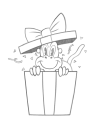Create two stages of a design
Stage 1 - Exploration Sheet: This is the initial stage where you are exploring and experimenting with the design. Try to show evidence of structure volumes, believable anatomy, and poses that feel true to your source material (which are apes in this case).
Stage 2 - Finished Design: Once you've found a design that works well in the exploration stage, refine it to a more finished state. This does not necessarily mean full color or setting it in a specific environment. It could simply be a cleaned-up line design where the shapes are more defined and not as loose or rough as in the exploration stage.
The assignment should demonstrate effort and intention to push beyond "good enough." Don't settle for the bare minimum, prove your capabilities with each task.
Compare your final design to a design you created before you started the course. This will serve as a control group to help you see the improvement in your work after taking the course.









